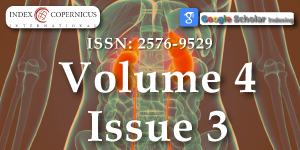Modification of the Renal Angina Index for identifying the need for renal replacement therapy in critically ill pediatric patients
Main Article Content
Abstract
Severe Acute Kidney Injury (AKI) is a common, serious problem affecting critically ill children that lacks effective treatment options. Currently, there are no treatment options for AKI other than supportive care. Continuous renal replacement therapy (CRRT) is employed to reduce Fluid Overload (FO) burden and treat metabolic disturbances in AKI. Identifying patients upon admission who may require CRRT has potential clinical care implications. The aim of this study was to determine if the RAI had diagnostic capabilities to identify patients who would require CRRT.
The analytic cohort consisted of patients who required CRRT and illness severity score matched controls who did not require CRRT at a single center. Patients who required CRRT had higher mortality rates, length of stay, and use of ventilatory and inotropic support. Sensitivity, specificity and area under the receiver operating characteristic curve (AUC) assessed and compared the discriminatory accuracy of three scores: 1) the renal angina index (RAI), 2) serum-creatinine (sCr) based AKI on day 0 and 3) modified RAI created with an additional RAI injury tranche that corresponded to severe stage 3 AKI sCr elevation.
Compared to Day0AKI (AUC 0.78, 0.70-0.87; sensitivity 0.63, 0.45-0.79; specificity 0.93, 0.870.97) and RAI (AUC 0.76, 0.69-0.82; sensitivity 0.94, 0.81-0.99; specificity 0.57, 0.47-0.66), the modified RAI had the highest AUC (0.79; 0.72-0.85) with a high sensitivity (0.91; 0.77-0.98) and moderate specificity (0.65; 0.56-0.75) for prediction of CRRT requirements. As a more accurate tool for discriminating patients in need of CRRT, a modified RAI has numerous potential implications. Identifying patients who ultimately require CRRT at an earlier timepoint may influence timing of CRRT initiation in an attempt to avoid further FO, or may influence nephrotoxin administration. The diagnostic capabilities of the modified RAI may be refined by the addition of urinary biomarkers. These findings should be validated in a larger cohort.
Article Details
Copyright (c) 2020 Stenson EK, et al.

This work is licensed under a Creative Commons Attribution 4.0 International License.
Kaddourah A, Basu RK, Bagshaw SM, Goldstein SL. Epidemiology of Acute Kidney Injury in Critically Ill Children and Young Adults. N Engl J Med. 2017; 376: 11-20. PubMed: https://pubmed.ncbi.nlm.nih.gov/27959707/
Slater MB, Anand V, Uleryk EM, Parshuram CS. A systematic review of RIFLE criteria in children, and its application and association with measures of mortality and morbidity. Kidney Int. 2012; 81: 791-798. PubMed: https://pubmed.ncbi.nlm.nih.gov/22258324/
Goldstein SL. Acute kidney injury biomarkers: renal angina and the need for a renal troponin I. BMC Med. 2011; 9: 135.
Basu RK, Zappitelli M, Brunner L, Wang Y, Wong HR, et al. Derivation and validation of the renal angina index to improve the prediction of acute kidney injury in critically ill children. Kidney Int. 2014; 85: 659-667. PubMed: https://pubmed.ncbi.nlm.nih.gov/24048379/
Basu RK, Kaddourah A, Goldstein SL. Assessment of a renal angina index for prediction of severe acute kidney injury in critically ill children: a multicentre, multinational, prospective observational study. Lancet Child Adolesc Health. 2018; 2: 112-120. PubMed: https://pubmed.ncbi.nlm.nih.gov/30035208/
Hanson HR, Carlisle MA, Bensman RS, Byczkowski T, Depinet H, et al. Early prediction of pediatric acute kidney injury from the emergency department: A pilot study. Am J Emerg Med. 2020. PubMed: https://pubmed.ncbi.nlm.nih.gov/32024590/
Sutherland SM, Alexander SR. Continuous renal replacement therapy in children. Pediatr Nephrol. 2012; 27: 2007-2016. PubMed: https://pubmed.ncbi.nlm.nih.gov/22366896/
Gist KM, Selewski DT, Brinton J, Menon S, Goldstein SL, Basu RK. Assessment of the Independent and Synergistic Effects of Fluid Overload and Acute Kidney Injury on Outcomes of Critically Ill Children. Pediatr Crit Care Med. 2020; 21: 170-177. PubMed: https://pubmed.ncbi.nlm.nih.gov/31568240/
Pollack MM, Holubkov R, Funai T, Dean JM, Berger JT, et al. The Pediatric Risk of Mortality Score: Update 2015. Pediatr Crit Care Med. 2016; 17: 2-9. PubMed: https://pubmed.ncbi.nlm.nih.gov/26492059/
KDIGO Guidelines on AKI. Kidney International Supplements. 2012; 2.
Zappitelli M, Parikh CR, Akcan-Arikan A, Washburn KK, Moffett BS, et al. Ascertainment and epidemiology of acute kidney injury varies with definition interpretation. Clin J Am Soc Nephrol. 2008; 3: 948-954. PubMed: https://pubmed.ncbi.nlm.nih.gov/18417742/
Hanley JA, McNeil BJ. The meaning and use of the area under a receiver operating characteristic (ROC) curve. Radiology. 1982; 143: 29-36. PubMed: https://pubmed.ncbi.nlm.nih.gov/7063747/
DeLong ER, DeLong DM, Clarke-Pearson DL. Comparing the areas under two or more correlated receiver operating characteristic curves: a nonparametric approach. Biometrics. 1988; 44: 837-845. PubMed: https://pubmed.ncbi.nlm.nih.gov/3203132/
Hayes LW, Oster RA, Tofil NM, Tolwani AJ. Outcomes of critically ill children requiring continuous renal replacement therapy. J Crit Care. 2009; 24: 394-400. PubMed: https://pubmed.ncbi.nlm.nih.gov/19327959/.
Riley AA, Watson M, Smith C, Guffey D, Minard CG, et al. Pediatric continuous renal replacement therapy: have practice changes changed outcomes? A large single-center ten-year retrospective evaluation. BMC Nephrol. 2018; 19: 268. PubMed: https://pubmed.ncbi.nlm.nih.gov/30340544/
Alobaidi R, Morgan C, Basu RK, Stenson E, Featherstone R, Majumdar SR, et al. Association Between Fluid Balance and Outcomes in Critically Ill Children: A Systematic Review and Meta-analysis. JAMA Pediatr. 2018; 172: 257-268. PubMed: https://pubmed.ncbi.nlm.nih.gov/29356810/
Sutherland SM, Zappitelli M, Alexander SR, Chua AN, Brophy PD, et al. Fluid overload and mortality in children receiving continuous renal replacement therapy: the prospective pediatric continuous renal replacement therapy registry. Am J Kidney Dis. 2010; 55: 316-325. PubMed: https://pubmed.ncbi.nlm.nih.gov/20042260/
Gorga SM, Sahay RD, Askenazi DJ, Bridges BC, Cooper DS, et al. Fluid overload and fluid removal in pediatric patients on extracorporeal membrane oxygenation requiring continuous renal replacement therapy: a multicenter retrospective cohort study. Pediatr Nephrol. 2020. 35: 871-882. PubMed: https://pubmed.ncbi.nlm.nih.gov/31953749/
Menon S, Goldstein SL, Mottes T, Fei L, Kaddourah A, et al. Urinary biomarker incorporation into the renal angina index early in intensive care unit admission optimizes acute kidney injury prediction in critically ill children: a prospective cohort study. Nephrol Dial Transplant. 2016; 31: 586-594. PubMed: https://pubmed.ncbi.nlm.nih.gov/26908772/





